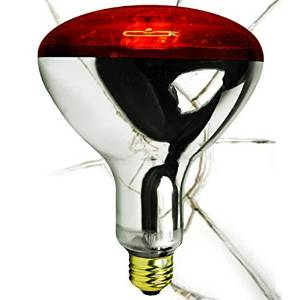 One of the inconvenient things about near infrared bulbs used for near infrared light therapy is that they are made of glass. They are fragile and can break easily if dropped. While this is an annoying problem with any sort of bulb, in the case of bulbs being used in near infrared saunas or near infrared light therapy, there’s the additional risk that the bulb could shatter during use if it is exposed to moisture. One of the biggest dangers of infrared light therapy, though, lies in shatterproof bulbs.
One of the inconvenient things about near infrared bulbs used for near infrared light therapy is that they are made of glass. They are fragile and can break easily if dropped. While this is an annoying problem with any sort of bulb, in the case of bulbs being used in near infrared saunas or near infrared light therapy, there’s the additional risk that the bulb could shatter during use if it is exposed to moisture. One of the biggest dangers of infrared light therapy, though, lies in shatterproof bulbs.
To solve this problem, some manufacturers began using polytetrafluoroethylene or PTFE, more popularly known by its brand name, Teflon, to coat the bulbs and sell them as “shatterproof”. A PTFE coating does indeed strengthen the bulb, making it resist breakage (although it is not fully break-proof). What most people do not know is that shatterproof near infrared bulbs release invisible, odorless fumes that are highly toxic.
It seems to be widely agreed that at low temperatures, PTFE is safe. However, at higher temperatures, the bonds in PTFE begin to break, allowing fluorocarbon gases to escape. At temperatures as low as 392 degrees Fahrenheit (200 degrees Celsius), PTFE coated near infrared bulbs will off-gas. Most near infrared light therapy bulbs reach temperatures of 450 degrees or more.
In some cases, exposure to PTFE gases will cause what is informally known as polymer fume fever in humans. Polymer fume fever can occur as a result of temperatures above 300 degrees, which is well below a near infrared bulb’s normal operating temperature of 450 degrees plus. Symptoms may be absent, or may include flu-like symptoms, such as fever, chills and headaches, as well as chest tightness, cough, a high white blood cell count and visible changes on chest x-rays. Those affected may not link PTFE bulbs to their symptoms, as onset is four to eight hours after exposure.
At temperatures above 450 degrees, PTFE decomposition and off-gassing is high enough to cause acute lung injury in humans. According to the Environmental Working Group, the following are released from heat-induced breakdown of PTFE.
- Tetrafluoroethylene (TFE)
- Hexafluoropropene (HFP)
- Octafluorocyclobutane (OFCB)
- Perfluoroisobutane (PFIB), which is a chemical warfare agent ten times stronger than phosgene
- Carbon tetrafluoride, or carbonyl fluoride (CF4), the fluorine analog of phosgene
- Trifluoroacetic acid (TFA)
- Trifluoroacetic acid fluoride
- Perfluorobutane
- Silicon tetrafluoride (SiF4)
- Monofluoroacetic acid (MFA), capable of killing humans at low doses
- Hydrofluoric acid, a corrosive gas
- Particulate matter
In baby chicks, parrots and other birds, exposure to off-gassing PTFE bulbs results in death.
Perhaps one factor contributing to the toxicity of PTFE fumes is the use of a chemical called perfluorooctanoic acid (PFOA) sometimes used to manufacture it. PFOA does not biodegrade and persists indefinitely in the environment. It is a known toxicant and carcinogen. Studies done due to a lawsuit against DuPont concluded that PFOA exposure is probably associated with kidney cancer, testicular cancer, ulcerative colitis, thyroid disease, high cholesterol and pregnancy-induced hypertension.
Needless to say, shatterproof bulbs are not the convenient substitute for real near infrared light therapy bulbs that they first appear to be. Unsuspecting consumers are being led to purchase a product that compromises their health and safety. This in and of itself is unconscionable. But consider that many people using these bulbs are trying to recover from devastating illnesses, to improve their health or just simply to detox and the sale of shatterproof near infrared bulbs for the purpose of near infrared light therapy takes on an even more devastating implication.